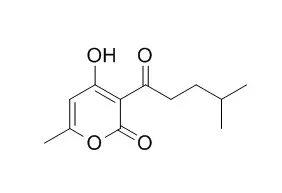| In vitro: |
| Chin Med J (Engl). 2014;127(23):4001-5. | | In vitro and in vivo antibacterial activity of Pogostone.[Pubmed: 25430439] | Our pervious antibacterial studies on several traditional Chinese medicines have found that Patchouli oil from Pogostemon cablin had significant antibacterial activity against methicillin-resistant Staphylococcus aureus (MRSA), which has spread worldwide and infected innumerable people. In order to find the more active natural substances in Patchouli oil, one of the major components, Pogostone, was isolated and its antibacterial activity was evaluated in vitro and in vivo in this study.
METHODS AND RESULTS:
In vitro test, Pogostone was screened for antimicrobial properties against 83 bacteria comprising 35 gram positive and 48 gram negative bacteria strains via the agar double dilution method. In vivo test, specific pathogen free (SPF) strain of both male and female white Kunming mice, weighing 18-22 g, were used to test the protective ability of Pogostone after being injected with the median lethal doses (MLDs) of the tested strains.
In vitro test, Pogostone could inhibit both gram negative bacteria (0.098-1 600 μg/ml) and gram positive bacteria (0.098-800 μg/ml). For Corynebacterium xerosis and some Chryseobacterium indologenes, the minimum inhibitory concentration (MIC) values of Pogostone were extremely low (<0.098 μg/ml). It was significant that Pogostone was also active against some drug-resistant bacteria like MRSA. Furthermore, Pogostone showed antibacterial activity in vivo against Escherichia coli (E. coli) and MRSA via intraperitoneal injection. Ninety percent of the mice infected with E. coil could be protected at the concentrations of 50 and 100 mg/kg, and 60% of the mice at 25 mg/kg, while the rate of protection for the mice infected with MRSA was 60% and 50% at doses of 100 and 50 mg/kg, respectively.
CONCLUSIONS:
Pogostone could be developed as a potential antibacterial agent for clinical therapy. | | J Ethnopharmacol. 2014 Nov 18;157:212-21. | | Pogostone suppresses proinflammatory mediator production and protects against endotoxic shock in mice.[Pubmed: 25256685] | Pogostemon cablin (Blanco) Benth is a well-known medicinal herb commonly used in many Asian countries for inflammatory diseases. Pogostone (PO), a natural product isolated from Pogostemon cablin, is known to exert various pharmacological activities. This study aimed to investigate the anti-inflammatory property of PO, to elucidate its mechanism of action, and to evaluate its potential acute toxicity.
METHODS AND RESULTS:
The in vitro anti-inflammatory activity of PO was assessed using lipopolysaccharide (LPS)-stimulated RAW264.7 macrophages. The protein and mRNA levels of proinflammatory mediators were measured with ELISA and RT-PCR, respectively. Proteins of the NF-κB and MAPK family were determined by Western blot to investigate the underlying molecular mechanisms. The in vivo anti-inflammatory activity of PO was tested using LPS-induced endotoxic shock in mice. In addition, the median lethal dose (LD50) of PO in mice was tested in an acute toxicity test.
In vitro, PO significantly inhibited the protein and mRNA expression of proinflammatory mediators including TNF-α, IL-6, IL-1β, NO, and PGE2. The action mechanism of the anti-inflammatory activity of PO was partly dependent on inhibition of the activation of NF-κB and the phosphorylation of JNK and p38 MAPK. In vivo, PO was able to significantly reduce the mortality induced by LPS in mice. Furthermore, PO could markedly suppress the production of the proinflammatory mediators in serum, and attenuate liver and lung injury. The action mechanisms of PO during endotoxic shock may be attributed to down-regulation of the mRNA expression of inflammatory mediators in multiple organs via inhibition of the activation of NF-κB and the phosphorylation of p38 MAPK. Moreover, the LD50 of PO in mice was about 163mg/kg with intravenous administration, which was about 8-fold higher than the dose used in the animal experiment.
CONCLUSIONS:
Our findings regarding the anti-inflammatory effect of PO and the underlying molecular mechanisms help justify the use of Pogostemon cablin in Chinese medicine for the treatment of inflammatory diseases. More importantly, the results also render PO a promising anti-inflammatory agent worthy of further development into a pharmaceutical drug for the treatment of septic shock. |
|
| In vivo: |
| Phytochem Anal. 2014 Mar-Apr;25(2):97-105. | | Characterisation of the metabolism of pogostone in vitro and in vivo using liquid chromatography with mass spectrometry.[Pubmed: 24605365] | Pogostone possesses potent anti-bacterial and anti-fungal activities and has been used for the quality control of essential oil of Pogostemon cablin. Pogostone is easily absorbed after oral administration but its metabolism in mammals remains elusive.
To investigate the metabolic profile of Pogostone in vitro and in vivo.
METHODS AND RESULTS:
High-performance liquid chromatography coupled with mass spectrometry (LC–MS) techniques were employed. Orbitrap MS and ion trap tandem mass spectrometry (MS/MS) were utilised to analyse the metabolism of Pogostone by virtue of the high sensitivity and high selectivity in the measurement. In vitro experiment was carried out using rat liver microsomes while the in vivo study was conducted on rats, which were orally administered with Pogostone (80 mg/kg).
In total, three mono-hydroxylated, one di-hydroxylated, one mono-oxygenated, one di-oxygenated metabolite, one hydrolysis and one hydroxy conjugated metabolites were found. In addition hydroxylation was demonstrated to be a major metabolic pathway of Pogostone.
CONCLUSIONS:
LC–MS was demonstrated to be a powerful tool for the metabolite identification of Pogostone. The tentative identification of metabolites provides an insight for the metabolic clues of Pogostone. |
|






 Cell. 2018 Jan 11;172(1-2):249-261.e12. doi: 10.1016/j.cell.2017.12.019.IF=36.216(2019)
Cell. 2018 Jan 11;172(1-2):249-261.e12. doi: 10.1016/j.cell.2017.12.019.IF=36.216(2019) Cell Metab. 2020 Mar 3;31(3):534-548.e5. doi: 10.1016/j.cmet.2020.01.002.IF=22.415(2019)
Cell Metab. 2020 Mar 3;31(3):534-548.e5. doi: 10.1016/j.cmet.2020.01.002.IF=22.415(2019) Mol Cell. 2017 Nov 16;68(4):673-685.e6. doi: 10.1016/j.molcel.2017.10.022.IF=14.548(2019)
Mol Cell. 2017 Nov 16;68(4):673-685.e6. doi: 10.1016/j.molcel.2017.10.022.IF=14.548(2019)